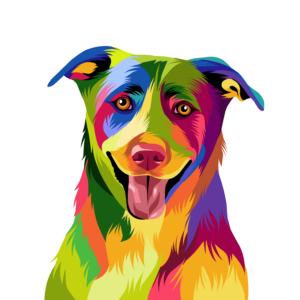
.
If you’ve recently adopted a dog or if your puppy is old enough to start going on walks, it’s not unusual to encounter a little bit of difficulty with leash training. Dogs may get excited, fearful, or overwhelmed by new surroundings. They may not inherently understand the dynamic of a walk, where you’re leading from behind them.
There are many methods and strategies to leash train dogs. Solutions like prong collars seem very easy on the surface, however it’s important to work directly with a veterinarian or behaviorist on how to use these, especially since some dogs may have sensitive tracheas that make prong collars unsafe to use for them in particular.
If you’re thinking about getting a prong collar and wondering how they work, here’s what you should know before you get one.
Prong collars are metal dog collars that are built similarly to metal chains. The collar is composed of many links, and on the inside of these links sit bent prongs in a slight “L” shape. These collars contrast significantly against normal dog collars, which are completely flat and smooth on the inside.
The prongs inside of a prong collar create pressure points against your dog’s neck and throat area. If your dog tries to pull or move on a leash, the prongs push against your dog’s neck.
These collars work by making your dog uncomfortable. Contrary to popular belief, the goal is not to injure the dog, and if the dog is getting injured, the prong collar is not being used correctly.
With any corrective collar or leash, the placement should be high on the neck, just behind the jaw bone. This higher placement gives you more control over your pet’s head, allowing you to pull them away from distractions, other animals, and people as needed.
While holding the leash, keep the length short and hold it up above their head. This will help you control their movement while they are still learning, and keep the collar in the correct, safe placement.
Setting your prong collar to properly fit your specific pet is essential for safety. Every dog is built slightly differently, and an incorrect fit could cause injury to your pet.
Prong collars have a very minimal amount of space for excess movement, usually just an inch or two. When buying your collar, it must fit snugly, but not too tightly. The prongs should not be digging in when there is no tension on the leash.
Some collars also come with extra links that can be added or removed for growing pups.
Some collars come with rubber optional covers over the prongs for added comfort. If your dog is just beginning to learn how to remain calm and not pull on the leash, the rubber covers should be added.
Prong collars are not meant to be left on for extended periods — at most, they should only be used during walks, and are really only recommended in more stressful situations such as large crowds or events where losing control of a reactive dog could cause injuries to others.
Similar to other corrective collars such as slip leads, choker collars, or shock collars, prong collars should be carefully and intentionally used as an aid training and correction.
Yes, the collar will be uncomfortable if the dog pulls or tugs at the leash.
In many cases, your dog will become hyper-focused on something they want, like trash on the sidewalk, another dog that’s barely out of sniffing distance, or even the idea that a young kid is itching to play with them.
You can’t have your dog jumping up on people or jerking towards other animals — much like humans, every dog will have their own personality, and a stranger won’t know if your pup is jerking to greet them or jerking to bite them.
Tools such as slip leads and prong collars are designed to make your pet uncomfortable so they can learn boundaries and behaviors that will ultimately keep them safer.
As the owner, it’s your responsibility to understand the difference between correction, and being too hard on your pet.
You never need to jerk and yank on your dog’s leash — that is the kind of movement that can seriously hurt them, prong collar or regular collar alike.
Instead, give a gentle tug, telling them “no” in a stern, serious voice, and take their attention away from the distraction.
If your pet continues to pull, you need to take the time to remove them from the situation or provide vocal coaching and guidance to help them understand what you want out of them.
Consistency is key. Always correct early and help your pet calm down. One helpful trick you can try when out and about in public is making them lie down, placing your foot in front of them when bikes or pedestrians are passing to give them the feeling of being protected.
Again: Never suddenly jerk or continue to pull forcefully on any collar, especially a corrective collar — this will injure your dog and can cause them to distrust you.
Proper training methods are meaningfully effective. They help your dog learn to behave without hurting your dog or damaging your bond with your dog.
You can leash train your dog yourself or work with an educated and responsible dog trainer that primarily uses positive reinforcement. The process isn’t difficult — it just takes some time.
If your dog pulls, tugs, or lunges, you should stand still. If you plant your feet firmly on the ground and become an immovable object, your dog will soon realize that they’re unable to run their own agenda. If you do this consistently, that’s often all it will take for your dog to get the message that they aren’t the leader of the walk. You can also pair it with a firm “no pull” to help reinforce the message.
Some dogs take to a leash right away. They get the message very quickly that you’re holding the other end of the leash and this puts you in the position of authority in that situation. Other dogs may be slower to learn or have other concerns about walks — be patient, especially if you’re working with a rescue who may not have had any leash training before you.
If your dog is used to getting their exercise and going potty in a fenced-in yard, the first few times they go on a walk may be a little overwhelming. This overwhelm isn’t always bad. It’s the result of a new world of sights, sounds, and smells. They’ll see a lot of people and other animals they’ve never encountered before.
This sensory overload may cause your dog to behave unpredictably. They may stop, run, turn, or chase. It’s a new experience, and they’re still taking it all in. A lot of patience is necessary when your dog is still learning about the outside world.
If your dog is highly energetic and loves going for walks, they may zip and zoom all over the place. It’s the same way a child reacts at a toy store. Your dog just wants to see everything and play to their heart’s content.
Your dog may not enjoy all the new sensory experiences of walks, preferring the shelter of a fenced-in yard or a cozy home. Your dog may stand still or try to hide between your legs if they find walks distressing. Look for trembling, drooling, whimpering, and excessive vocalization. These are usually signs that your dog is upset.
If your dog needs a little extra help going for walks, here’s what you can do to accommodate their needs as they’re learning the ropes.
If your dog gets overwhelmed on walks, walk the same path twice a day. The path will begin to become increasingly familiar to the point where your dog will eventually find it boring. Slowly introduce your dog to new paths or incorporate additional turns down other streets in your neighborhood.
Over time, these small changes will go a long way in helping your dog realize that walks are nothing to be afraid of.
If your dog is nervous about the presence of other animals, you can get a leash or a vest that denotes that your dog needs space. Walk as far away from other animals as possible. This may continue to be the case throughout your dog’s life, far beyond the leash training phase, but there’s a good chance that your dog will become less fearful or nervous of other people and animals with frequent distanced encounters.
Listening to your dog, staying in place, and helping to keep your pet calm are the best ways to help your dog walk on a leash.
Always make sure any collar you use is fit properly, and lead training with positive reinforcement and rewards for best results.
Good luck!
Sources
Dog collars | The Humane Society of the United States
How to Leash Train a Dog or Puppy to Walk on a Leash | American Kennel Club

These statements have not been evaluated by the Food and Drug Administration. These products is not intended to diagnose, treat, cure, or prevent any disease.
The world of pet wellness is always evolving. Get notified about new product launches, news, and more!
Due to state laws, we are unable to ship product to Idaho, Kansas, South Dakota, and Nebraska.
VetCBD products are made using hemp containing less than 0.3% THC.